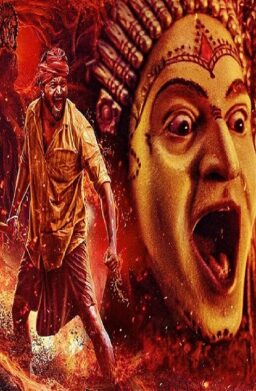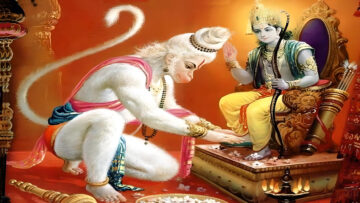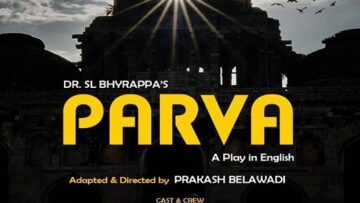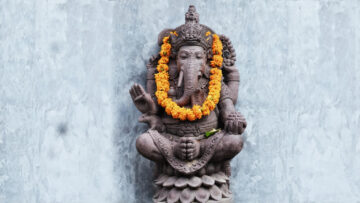As we speak, the cinegoers of India are in the midst of an intense experience for which they were not prepared. A movie, made in a language spoken by a fraction of the population, representing the traditions of few districts within that population, made with very few known faces – with very less collective experience, has captured the imagination of an entire nation. It is an imagination that is hardly supported in mainstream art and narrative. Yet, even to people who are forced to move away from that imagination, it is so familiar and deep within their consciousness that a single stroke from this movie has sprung a fountain of it. Here, we present a small summary of its artistic and cultural achievement – which is still in the making and process. The real impact can only be assessed when it has run its due course.
The First Achievement: With this movie, our traditions, our dEvatAs, and our sense of sacredness are back into mainstream cinema. We had lost them for a few decades even in the Kannada industry, while some other industries had moved away right from the beginning. With Kantara, we have brought them with a bang – right into the sanctum sanctorum of the Cinema – as an integral part of the plot, narration & essence of the piece, rather than being an also present element of the cinema. The Daiva is not just back but the Daiva itself is the cinema.
The Second Achievement: This reformation of the cinema contributes in both the substance and the form. With Kantara, we have regained independence from ‘Realism’ as the primary form of telling a story. We have, of course, had our ‘Nagins’ & Magadheera-s. But our non-realism cinema merely limited themselves to fantasy & entertainment. They were shy attempts. Kantara, though, is an unabashed foregrounding of the Indian form of storytelling and narrative. The Myth merges with the Real. The resulting Visual storytelling form is a universal one that is relevant to all kinds of stories – rather than a limited set called fantasy limited for entertainment. Kantara presents a form of storytelling where the Myth is not a separate genre. Rather it is another real experience one that elevates the mundane physical reality.
The Third Achievement: Kantara has brought back the Deseeya – the folk – to the national centre-stage. It is a triumph of the Deseeya form. What Bahubali 1&2 were for the Margeeya – the Classical, Kantara is for the Deseeya – the Folk. Bahubali could have happened anywhere in Bharatavarsha at any point in time. But Kantara’s physical co-ordinates are marked to a few districts around coastal Karnataka. But there is an additional achievement. The Deseeya in the movie touches the Margeeya at its core & peak. Panjurli Daiva, Guliga, Folk Dance, Sanskrit & Classical Music are together. The Deseeya speaks the language of Margeeya (Dharma) seamlessly in the movie. This demonstration of the seamless co-existence of the two, one reaching the other at its peak, is another phenomenal achievement. Importantly, this is not done forcefully or ideologically or with a political intention that is apparent. It just comes out as the presentation of a matter of factly reality and without disturbing the artistic integrity of the movie.
The Fourth Achievement: In the last 300 years, India has seen many historical conflicts flowing through its time-line. The cycle of conflict-resolution-synthesis is in a mighty repetition. Kantara presents one such grand Civilizational/Cultural conflict going through a very simple story. The movie is about two conflicts
- A forest community and its clash with Modernity, the State and the dynamic of Progress/Development.
- A conflict within the forest community between Greed (Artha, Kama) and the Divinity (Dharma/Moksha) within the culture.
The achievement is in presenting this conflict, in its multifacetedness and complete cycle, through a very simple story. This is a typical genius of our Janapada form. All participants in this conflict go through a complex journey and a transformation. The emerging metaphors the movie captures are fascinating. The forest community hates the intervention of the State, represented by the forest officer. The forest officer duty-bound to perform certain duties is detests their obstruction. Both do not understand each other’s intentions and potentials. Rather, both see each others’ methods and performances as detrimental and having bad intentions. In addition, the forest officer is taught by Modernity to look down upon the traditions of the forest community – ideologically. Yet, the forest community is unable to see the evil within to which they have submitted themselves. It can only do so with support from the forest officer. The forest officer too progresses in his objective only with the support of the forest community. Yet, this whole process is set forth by the Daiva itself. It is the active invocation of the Daiva by the forest community and the eventual recognition of its power by the forest office that creates a resolution and the way forward – presented with cinematic brilliance in the last few scenes of the movie. That this complex narrative does not result in an ideological or political excess in the movie harming the aesthetic experience of the movie – is another additional achievement in this context. This is a grand criticism of both the Modern Secular State and a recognition of the traditional community’s necessity to move forward by engaging with Modernity.
Kantara is a simple Folk Story but an extraordinarily rich detail that will shame a modern anthropologist. It’s amazing that so much detail can be packed into a single movie while using every detail to present a dimension of the story. This is indeed a literary & visual achievement. Explaining this in a minute detail will make a longer essay. The whole movie is shot within a few square kilometres. All innovation/investment is towards set making for every scene. It involves no foreign travel, no grand localing and unnecessary expenditure. There may be VFX and other technology. But it is so invisible and is not a selling point of the movie, in spite of ticking all boxes of a fantasy. This is such an emancipation for future makers. This is the right paradigm of creating a piece of art – technology must be subservient to art and culture.
From the making stand-point, Kantara shines in every department of the craft – Acting, Cinematography, Editing, Music, Script, Lyrics, Dance – literally everything. But the critical difference lies in three elements
- The confidence to pick such a subject
- To have the right cultural vision and perspective
- To be able to craft that into a cinema and direct it to the last detail
That’s the phenomenal achievement of Rishab Shetty. He has shown the potential of being a good artist in his previous movies. But, with Kantara, he has achieved that ‘‘hanumad-vikAsa हनुमदविकास’. He has leapt into the sky and reached another orbit of cinema.
The execution ticks many boxes of a well-made-movie. Every single character in the movie contributes to the whole in a unique way. Nobody is more/less important except the protagonist himself. The lead actress is not a property unlike in many movies. She has a distinct personality and plays a role in the transformation of the protagonist and the community. She goes through her own crisis in the process. Characters largely silent also make a difference to the movie. Their silences play a part in the larger narrative and cinematic experience the movie creates. All other prominent and minor roles are all well etched, of course. They undergo their own transformation in the due course of the movie. The movie is a definite triumph of characterisation.
Acting is just absolutely brilliant in the movie. Rishab deserves an extra dose of credit for having extracted such good performances from so many different characters even as he himself has essayed the role of his life. Sapthami Gowda is perfectly cast in her role presenting a quick journey from innocence to responsibility. Protagonist’s brother Guruva depicts the Kola performer’s sense of sacredness in every appearance with almost no dialogues. Veteran actor Achyut Kumar deserves all the hate – such a Villain. Kishore, the police officer, personifies the blind arrogance of the Modern State. The young Manasi Sudhir stunningly essays the role of an aged mother who has seen all the rough sides of a tough life.
Once again Ajaneesh Lokanath impresses in the Music – both in songs and in the background. Ever since he erupted onto the silver screen through ‘uLidavaru kaMDaMte’ he has retained the ability to spring a surprise and present something unforgettable. The whole music is a great fusion of traditional, classical, folk and new modern instruments and style. This fusion itself is another significant feat of the movie. Two main songs are both brilliant. Throughout, every scene has an understated but culturally fitting music. Extraordinary orchestration of Kola, Folks Songs. The folk and the classical co-exist even in the movie subtly emphasizing the subject of the movie. It is no exaggeration to say that the music itself is another character in the movie.
After Direction, if there was one department with equal complexity it was Editing. A good script can be destroyed on the editing table. In Kantara, the editing department may have triumphed as much as the Script and Direction. It has resulted in the movie having multiple textures at once – at once a story, a visual, a documentary, a musical, action, fantasy. So much detail, so many forms, so many elements drawn from a rich life and culture. All scenes well knit into a brilliant overall movie. Finally, the movie looks like one monolith in spite of such diversity in scenes, rhythms and so on.
People in the language department too deserve a call-out. The language used in the Script, Dialogues, Lyrics – beautiful Kannada/Tulu from Coastal Karnataka with a Kundapura flavour I guess. The literature of the script is aesthetically brilliant. When an English word comes it plays a role to depict an aspect of the character/community. Otherwise, its a great mix of Tulu, Kannada, Sanskrit to depict the reality of the situation. It all looks like a single language. The acoustic experience of the movie is elevated by the sound of its language.
While the diversity challenge was high in Editing, I would still single out Cinematography for a special appreciation. For this movie with all its traditional, folk, forest, local detail, diverse elements, Divine experiences, the kind of action it has, innovative Cinematography was needed. Finally, it wins because it offers a Divine experience which is central to the subject of the movie. This is not achieved in isolation – It does so throughout.
Finally, if there is excellence in so many departments of a movie – it is the director who deserves a call-out. It is Rishab Shetty all the way. It’s his Vision, Direction, Script and Acting. A performance of his life – with Shraddha & Sanskriti, of Authenticity, Devotion, Sense of Purpose. Metaphorically speaking, through this movie, he has truly fulfilled his Pitr Rna, Daiva Rna, Samaja Rna. He has brought back a civilizational fundamental into the centre-stage of cinema. The movie stands-out for two reasons – Excellence & Authenticity. The latter is a consequence of the lived experiences of Rishab (& his team). It has made a difference to his life and possibly a few others in the movie. They have made this movie first for themselves & then for the audience.
Thus, Kantara is a grand case for Business subservient to Culture.
The Cultural Importance of Kantara
While being a great piece of art, Kantara is very important for us culturally and civilizationally as well. It brings back a mighty confidence in the Local. It demonstrates that the local in India touches the universal – artistically and in business. The subject of the movie is both ‘Unity in Diversity’ & ‘Diversity in Unity’ at once. The former is bottom-up and the latter is top-down. We are a philosophy that actively seeks and drives diversity. We are a philosophy that recognizes diversity and weaves it into the whole.
The movie represents both phenomenon in its substance and form. In its business success, it represents the former. It shows that the Diversity never comes in the way of Unity. Across India people are watching it either in its dubbed form or in Kannada with subtitles – with appreciation. This brings back the confidence in the local – be Local in your substance. You can still be universal in relevance. Make a movie about a small corner of the universe without inferiority, atrocity but present its cultural essence, beauty & perspective. Kashi will love a story from Kundapura.
It completely alters the way of storytelling as we have seen the modern mainstream. The Story has elements from Fantasy, Puranas, Realism, Musical, Exaggeration, Visual, Folk & Classical. It is a phenomenal artistic achievement weaving into a form to tell a Contemporary Story with a sense of Past, Present and Future. This is how India always tells a story if one reads classical literature such as Kadambari of Banabhatta or Kathasaritsagara. That form of storytelling is now back. This results in the experience of Time as a seamless continuous flow. Thus the movie achieves another civilizational differential – the Saatatya – a unity of Time rather than isolating the past, present and future.
Kantara demonstrates in its subject and experience that Divinity is an integral part of our lives. Keeping Divinity away from our art forms we have impoverished our artistic products as well as our lives. In this aspect, Kantara is one big leap in the grand journey of Decolonization – without using that word – a nudge for us to use our own Lenses. This needs no special explanation if one has gone through the last 20 minutes of the movie. It is no exaggeration to say that it is a cinematic first for India. Rishab becomes the character he portrays. The audience lose their sense of separation from the cinema, the forest community, the story and the very Time. This is typically achieved in our Janapada art forms. But it is an absolute rarity in cinema. It is an absolute first experience of Transcendence in a modern art form – attested by nearly everybody in some form or the other. This is without a parallel. Its Divinity & Transcendence without exaggeration. It performs cathartic correction in your mind and creates a beautiful silence. Most people have reported that the audiences simply leave the theater quietly not wanting to disturb their silences – for that is too rare an artistic experience in our times.
Kantara is just that one thing that I have longed for forever in a movie without being aware of it. Hopefully, this cathartic correction, takes our cinema, art in a different direction and flows into other aspects of our civilizational spaces.
Feature Image Credit: cinemaexpress.com
Disclaimer: The opinions expressed in this article belong to the author. Indic Today is neither responsible nor liable for the accuracy, completeness, suitability, or validity of any information in the article.











